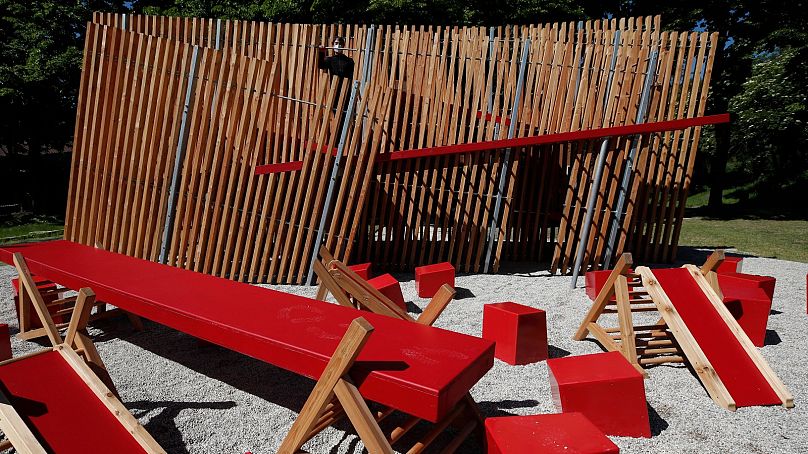The international architecture show addresses political and religious polarization, the quest for space and human collaboration.
This year's Biennale examines how architecture can address global issues such as political and religious polarization, the quest for space, or simple human collaboration.
Seen as a neutral place, the Venice event offers the ground, the space, and a time for dialogue.
Chilean architect Alejandro Aravena, who curated the 2016 architecture Biennale, has created a space where he hopes Chileans and the Mapuche indigenous people can meet to discuss age-old disputes over land.
The architecture, created by his Elemental studio, meets criteria stipulated by Mapuche tradition: that it be circular with an eastward orientation, made of wood and vertical.
Aravena's team took wooden piles of the sort used to support Venetian palaces, and crisscrossed them in a circular pattern to create an interior courtyard.
It has been built on the side of a canal inside the Arsenale, the spiked tops of its piles visible from a distance, with the hopes that both Mapuche and Chileans could travel to Venice and hold a parley, or traditional negotiation.
But the coronavirus pandemic has made that uncertain.
"Given there has been there has been this long history of conflict between Chileans and Mapuche, we thought why not recover the old tradition of parleys to negotiate and talk," says Aravena.
"It was supposed to host Chileans and Mapuche having a negotiation here, it's not clear if it's going to happen or not, but in any case these logs are travelling back to Chile, to build that place to parley."
Life beyond earth showcase
And while some try to resolve issues on Earth, others have opted to aim for the stars, or rather the moon.
The project Life Beyond Earth showcases a moon village that overcomes the constraints of an extreme environment by utilizing advancements in technology that are currently available or in development.
The project developed by Skidmore, Owings & Merrill and the European Space Agency aims to show that global cooperation between multiple nations and multiple partners to combine their expertise towards the common objective is indeed possible.
They estimate the Moon Village could be created in just five years' time.
"I am an optimist by heart, the Biennale has been organized optimistically, around this question of how will we live together," says Colin Koop a design partner at Skidmore, Owings & Merrill.
"What we would like to do with this particular portion of the exhibition, is to show that it is possible to build a collaborative future which is focused on all of those shared values and concern for the planet, a sort of knowledge that there are more things that unite us than divide us - biologically, culturally, politically, those things are possible to express in a new kind of living arrangement, a new kind of settlement."
But before embarking on a shuttle to the Moon the Britain pavilion has chosen to explore how we will live together with the increasing privatization of public spaces.
The project called 'The Garden of Privatized Delights' has transformed the pavilion into a series of public spaces under threat that can be reimagined and revitalized, such as the garden square or the famous British pub.
Another British project shows how Muslim communities have been able to use different spaces to create mosques.
'Three British Mosques' on display
'Three British Mosques' displays reproductions of three mosques created in a former church and former synagogue, a pub, and a semi-detached house.
In Britain, anyone can start a mosque and the creation of these spaces are grassroots projects and crowd-funded by communities that come together for the creation of a common place of worship.
"What you see in these buildings is the way in which these communities shape the space and create their own visual language, their own esthetics, their own architecture, but then also they are continuously aspiring to create better and bigger and more established buildings," explains Shahed Saleem, Co-Curator of "Three British Mosques" project.
The 17th edition of the Architecture Biennale has also dedicated a part of the exhibition to children, in a project called 'How will we play together?'.
Five international architects have designed an installation on display at Forte Marghera that is open to the public.
For Alessandra Cianchetta, who designed the project 'Field of Lines', the space is open to interpretation, whether by children or adults.
"It's not really a playground but people can play and invent the rules of these new games that are not there yet," she says.
"I think the main thing is not to give preconceived rules but to have people invent those rules."
The 17th International Architecture Exhibition opens on 22 May after a one-year pandemic delay and will run until 21 November 2021.



